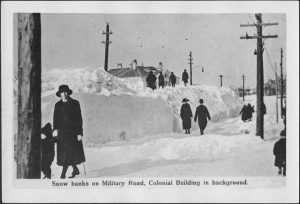ARCHIVAL MOMENT

Photo Credit: The Rooms Provincial Archives: E 20-25; Crowds in Bannerman Park long before the Annual Folk Festival.
Engaging Evenings at the Rooms
Wednesday, November 20, 2013 at 7pm
BANNERMAN PARK – IF THESE TREES COULD TALK
From a tent city after The Great Fire to the Colonial Building Riot; from courting lovers to a game of curling, Bannerman Park is a cherished landmark immersed in history. Join The Rooms archivist Larry Dohey, for a look at the history of Bannerman Park and hear stories that will sure to make you smile. Perhaps you have a story to share.
Bannerman Park in St. John’s has long been a cherished city landmark, a landmark that has over the years seen a variety of improvements to help modernize the park while staying true to its original Victorian character. The Bannerman Park Foundation are now engaged in the revitalization of the park with calls for residents to support the many projects that the foundation are undertaking.
Wind back the clock.
Just as in 2013 there is a call for the revitalization of Bannerman Park, so it was in 1887. It was in April 1887 that some residents of the city began to groan that:
“summer is coming again and nothing has been done to lay out or improve the vacant space.”
The residents of St. John’s complained that the enemies of the Park were the wild goats and foxes that have made the Park their refuge and the two legged enemies of the Park the residents of Flavin Street who have been taking the pickets from the fence turning it into “handy fuel.” In short the people of Flavin Street were using the fence that surrounded Bannerman Park for fire wood!!
The residents of the St John’s were determined. They argued that every other city in the world had a substantial park and that they too should have a Park to revel in.
Critics of putting money into Bannerman Park in 1887 argued:
“nature has been so kind to us around St. John’s that the whole countryside is one extended Park which spreads out like the sparking tale of a demonstrative peacock when summer comes and the sun shines.”
The supporters of the Bannerman Park countered:
“We believe that art is nature to advantage dressed, and we want so rural retreat, within easy access of the town, where the tired tramp may repose his exhausted limbs when the sun goes down and dream of that happy Elysium where insects bite not, nor mosquitoes sting, but where the wick’ud cease from troubling and the weary are at rest.” Yes, we want a Park! “Other things being equal,” we want the Park, the one and only park, the Bannerman Park.”
As with all revitalization projects, funding such a project, have always been a concern.
In 2013 the Bannerman Foundation are actively courting private and corporate dollars and partnering with the city. In 1887 the suggestion was “that legislators put another cent or two per bushel on potatoes and give us the Park at once.”
In 1887 supporters of the Park said :
“Not much is required. A little seeding and a little draining.” They dreamt that in time you would find in Bannerman Park “cool shade trees and babbling brooks, of grottos and labyrinths, (fancy a labyrinth in Bannerman Park!) of groove’s and blarney. Nay, even the strawberries and cream, also, especially cream.”
One hundred and twenty six years later supporters of the Park dream of:
“ a refrigerated skating trail, a new pavilion, a splash pad, an upgraded playground, the Garden of Memories, and a new pool house, upgraded pathways, new trees and flower beds, and new Victorian styled fixtures such as benches and lamps.!!
Located on the north side of Military Road next to Government House and the Colonial Building, Bannerman Park takes its name for Governor Alexander Bannerman, who in 1864, donated Governor’s lands in the vicinity of Government House for a public park for the use and enjoyment of the citizens of St. John’s.
It was shortly after the land was presented as a gift that residents of St. John’s that “ the ‘learned doctor’ Dr. John Joseph Dearin, and his friends” began to plant trees in the park. Many unfortunately “went to moult” the number one enemy of the park from its inception until the 1890’s were the goats that roamed the town.
It was after the appeal for residents for a more formal park in April 1887 that city officials began to seriously consider what to do with the land that had been left by Governor Bannerman. In 1891, the City of St. John’s funded the design and development of the Park as a formal Victorian Garden.
The rest is history evolving.
Recommended Reading: Stories About Bannerman Park: http://www.bannermanpark.ca/stories/
Recommended Action: Support the Garden of Memories in Bannerman Park: People who enjoy the park can contribute to the park‘s revitalization through by sponsoring various fixtures, flower gardens, and commemorative granite stones, which will be used for the pathways in the Garden. For more information: http://www.bannermanpark.ca/the-garden-of-memories-open-to-the-public/



